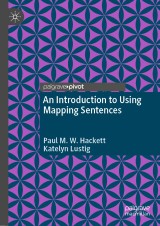Details

An Introduction to Using Mapping Sentences
|
69,54 € |
|
| Verlag: | Palgrave Macmillan |
| Format: | |
| Veröffentl.: | 24.08.2021 |
| ISBN/EAN: | 9783030785826 |
| Sprache: | englisch |
Dieses eBook enthält ein Wasserzeichen.
Beschreibungen
<div><p>This book acts as an introductory guide to understanding and using the mapping sentence as a tool in social science and humanities research. The book fills the need for a concise text that simply instructs how and when to use a mapping sentence and provides practical examples. Mapping sentences are a major research component and tool of facet theory. The book begins by covering the background to mapping sentence, including the philosophy and theory underpinning it. The following chapter discuss what mapping sentence is, what different kinds of mapping sentences exist, and knowing when and which to use it in a given situation. The book then moves into describing how to write a mapping sentence and how to analyse the information gained from mapping sentence research. It ends with a consideration of the future developments of mapping sentences and their applications across the social sciences and humanities, including in particular psychology, marketing, behavioural biology,art and health.</p></div><div><br></div><div><br></div>
Chapter 1 Background to Facet Theory.- Chapter 2 Mapping sentences defined.- Chapter 3 Different types of mapping sentences.- Chapter 4 Developing a mapping sentence.- Chapter 5 Examples of Mapping sentences.- Chapter 6 Analysing the information that arises from research designed using a mapping sentence.- Chapter 7 Conclusions.
<p><b>Paul M.W. Hackett</b> is a visiting professor at the University of Suffolk, UK and has published widely on facet theory in books and articles. He has PhDs in psychology and in art and has held academic positions at Durham, Cambridge, Oxford and Birmingham in the UK and at Tufts Universities and Emerson College in the US. Hackett developed the declarative mapping sentence as an approach to qualitative and philosophically oriented research.</p><p> </p><p> </p><p><b>Katelyn Lustig</b> is a writer and researcher with a bachelor's degree in marketing communication from Emerson College, USA. She has co-authored two books on Facet theory and the mapping sentence. She translates these research tools and theories in a manner that students may be able to better understand and appreciate in simpler terms.</p><br>
<p><i>“</i>This book presents a concise introduction to a research methodology that is particularly apposite to the social and behavioural sciences. It is written by two experts who have themselves used and developed the mapping sentence approach through their own empirical research and theoretical deliberations. It brings together a wealth of ideas and insights that will be of value to new and experienced scholars alike.”</p>
<p>Professor Gordon R. Foxall, Distinguished Research Professor, Cardiff University, UK and Visiting Research Professor, Reykjavik University, Iceland</p>
<p> </p>
<p>Professor Gordon R. Foxall, Distinguished Research Professor, Cardiff University, UK and Visiting Research Professor, Reykjavik University, Iceland</p>
<p> </p>
Introduces readers to mapping sentences Provides concrete examples for when and how to use mapping sentences in applied and theoretical research Considers the future developments of mapping sentences and their application
<p><i>“</i>This book presents a concise introduction to a research methodology that is particularly apposite to the social and behavioural sciences. It is written by two experts who have themselves used and developed the mapping sentence approach through their own empirical research and theoretical deliberations. It brings together a wealth of ideas and insights that will be of value to new and experienced scholars alike.”</p><p>Professor Gordon R. Foxall, Distinguished Research Professor, Cardiff University, UK and Visiting Research Professor, Reykjavik University, Iceland</p><p> </p>“Reading <i>An Introduction to Mapping Sentences</i> I was surprised to see how the authors were able to bring the concept of Mapping Sentence to new heights. They should be commended on this accomplishment.”<p></p><p> Professor Jacob Hornik, Coller School of Management, Tel Aviv University, Israel</p><p><br></p><p>The facet theory is an asset to every researcher and scholar worldwide. It enables the formal and systematic definitions of the underlying components of diverse types of phenomena (such as: personality, economic trends, bird behavior, and far more). This, invariably, aids in excelling research in any field. I congratulate the authors of this book on their important and vital work with the solemn aim of increasing awareness to the benefits of the facet theory by explaining this essential theory from base-level up, while focusing on the cardinal component in the theory - the mapping sentence. By illustrating the use of the mapping sentences, the authors considerably contribute to developing better and higher-quality research venues and scholars altogether, especially when defining complex phenomena that require conceptual sophistication. <br></p><p> <p><b> Dr Edna Rabenu, Bar-Ilan University, Israel</b></p><br></p>
Diese Produkte könnten Sie auch interessieren:

Prospektiv valide emotionale Phantasie als Teilaspekt der emotionalen Kompetenz

von: Irina Broich

48,00 €















